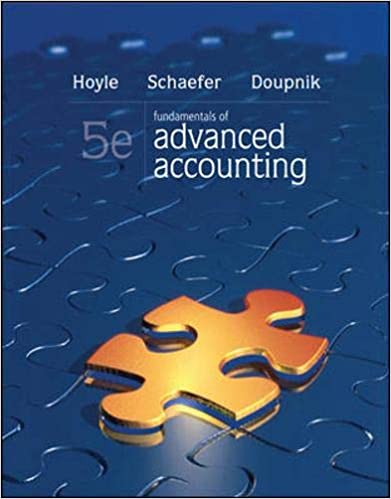
Fundamentals of Advanced Accounting 5th Edition by Joe Ben Hoyle,Thomas Schaefer,Timothy Doupnik
Edition 5ISBN: 978-1260575910
Fundamentals of Advanced Accounting 5th Edition by Joe Ben Hoyle,Thomas Schaefer,Timothy Doupnik
Edition 5ISBN: 978-1260575910 Exercise 38
Diekmann Company, a U.S.-based company, acquired a 100 percent interest in Rakona A.S. in the Czech Republic on January 1, 2012, when the exchange rate for the Czech koruna (Kc s) was $0.05. Rakona's financial statements as of December 31, 2013, two years later, follow:


Additional Information
• The January 1, 2013, beginning inventory of Kc s 6,000,000 was acquired on December 18, 2012, when the exchange rate was $0.043. Purchases of inventory were acquired uniformly during 2013. The December 31, 2013, ending inventory of Kc s 8,500,000 was acquired in the latter part of 2013 when the exchange rate was $0.032. All fixed assets were on the books when the subsidiary was acquired except for Kc s 5,000,000 of equipment acquired on January 3, 2013, when the exchange rate was $0.036, and Kc s 12,000,000 in buildings acquired on March 5, 2013, when the exchange rate was $0.034. Straight-line depreciation is 10 years for equipment and 40 years for buildings. A full year's depreciation is taken in the year of acquisition.
• Dividends were declared and paid on December 15, 2013, when the exchange rate was $0.031.
• Other exchange rates for 1 Kc s follow:

Part I. Translate the Czech koruna financial statements at December 31, 2013, in the following three situations:
a. The Czech koruna is the functional currency. The December 31, 2012, U.S. dollar- translated balance sheet reported retained earnings of $22,500. The December 31, 2012, cumulative translation adjustment was negative $202,500 (debit balance).
b. The U.S. dollar is the functional currency. The December 31, 2012, Retained Earnings account in U.S. dollars (including a 2012 remeasurement gain) that appeared in Rakona's remeasured financial statements was $353,000.
c. The U.S. dollar is the functional currency. Rakona has no long-term debt. Instead, it has common stock of Kc s 20,000,000 and additional paid-in capital of Kc s 50,000,000. The December 31, 2012, U.S. dollar-translated balance sheet reported a negative balance in retained earnings of $147,000 (including a 2012 remeasurement loss).
Part II. Explain the positive or negative sign of the translation adjustment in Part I( a ) and explain why a remeasurement gain or loss exists in Parts I( b ) and I( c ).


Additional Information
• The January 1, 2013, beginning inventory of Kc s 6,000,000 was acquired on December 18, 2012, when the exchange rate was $0.043. Purchases of inventory were acquired uniformly during 2013. The December 31, 2013, ending inventory of Kc s 8,500,000 was acquired in the latter part of 2013 when the exchange rate was $0.032. All fixed assets were on the books when the subsidiary was acquired except for Kc s 5,000,000 of equipment acquired on January 3, 2013, when the exchange rate was $0.036, and Kc s 12,000,000 in buildings acquired on March 5, 2013, when the exchange rate was $0.034. Straight-line depreciation is 10 years for equipment and 40 years for buildings. A full year's depreciation is taken in the year of acquisition.
• Dividends were declared and paid on December 15, 2013, when the exchange rate was $0.031.
• Other exchange rates for 1 Kc s follow:

Part I. Translate the Czech koruna financial statements at December 31, 2013, in the following three situations:
a. The Czech koruna is the functional currency. The December 31, 2012, U.S. dollar- translated balance sheet reported retained earnings of $22,500. The December 31, 2012, cumulative translation adjustment was negative $202,500 (debit balance).
b. The U.S. dollar is the functional currency. The December 31, 2012, Retained Earnings account in U.S. dollars (including a 2012 remeasurement gain) that appeared in Rakona's remeasured financial statements was $353,000.
c. The U.S. dollar is the functional currency. Rakona has no long-term debt. Instead, it has common stock of Kc s 20,000,000 and additional paid-in capital of Kc s 50,000,000. The December 31, 2012, U.S. dollar-translated balance sheet reported a negative balance in retained earnings of $147,000 (including a 2012 remeasurement loss).
Part II. Explain the positive or negative sign of the translation adjustment in Part I( a ) and explain why a remeasurement gain or loss exists in Parts I( b ) and I( c ).
Explanation
"Foreign Currency transaction:"
"In case...
Fundamentals of Advanced Accounting 5th Edition by Joe Ben Hoyle,Thomas Schaefer,Timothy Doupnik
Why don’t you like this exercise?
Other Minimum 8 character and maximum 255 character
Character 255


